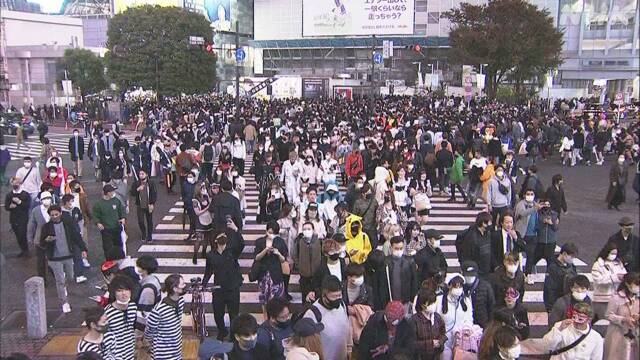October 31st was Halloween, but how was the crowd in the city?
Big data analysis of the number of people from October 29th to the early morning of November 1st shows that in downtown areas such as Shibuya in Tokyo, it is late at night compared to the average of the previous four weeks. It turned out that the rate of increase increased as it increased.
Using big data collected by NTT Docomo from mobile phone base stations in a privacy-protected manner, we analyzed the number of people in each region from noon on Friday, October 29 to early dawn on November 1, and analyzed the previous 4 Compared to the average for the same time period of the week.
Analyzing Tokyo with a mesh
First, the 23 wards of Tokyo were divided into 500 meters square, and the points where the number of people increased by 10% or more are shown in red, and the points where the number of people decreased by 10% or more are shown in light blue.
As a result, from around 9 pm on October 31st to the early morning of November 1st, the number of red areas showing an increase has increased, mainly in downtown areas along the Yamanote Line such as Shibuya, Ikebukuro, Shinjuku, and Ueno. rice field.
It is also thought that the fact that all the requests for shortened hours to restaurants overlapped on Halloween was also a factor.
Depending on the location, it is possible that the movement of people involved in the ballot counting of the elections that lasted into the middle of the night had an effect.
Graph comparing the previous 4 weeks
Of these, let's take a closer look at the area around Shibuya Station, which is crowded with people in disguise every year.
There is no significant change during the day compared to the previous four weeks on either day, but you can see that the rate of increase increases later in the night.
Friday, October 29, 10 pm was 1.3 times, Saturday, October 30 was 1.4 times, and after the 31st, it was doubled at midnight on November 1.
Let's take a look not only in Tokyo but also in downtown areas.
Similar to Tokyo Shibuya, the areas around Shinsaibashi and Dotonbori in Osaka are increasing at a higher rate in the later hours of the night compared to the previous four weeks.
In all cases, it was 1.2 times on the 29th, 1.4 times on the 30th, and 1.8 times on the 31st at 10 pm.
The same tendency was observed near Tenjin and Nakasu in Fukuoka, with the numbers at 10 pm on the 29th and 11 pm on the 30th being 1.2 times higher, and at 10 pm on the 31st being 1.4 times higher.
In Fukuoka, the Kego Park in Tenjin, which is crowded with people in disguise every year, is restricted from entering at night as an infection control measure, and it seems to be one of the reasons why the increase was small compared to Shibuya and Osaka.

